Wenwu Ou
GRADE: Personalized Multi-Task Fusion via Group-relative Reinforcement Learning with Adaptive Dirichlet Exploratio
Oct 09, 2025Abstract:Overall architecture of the personalized multi-objective ranking system. It comprises: (1) a Feature Center and Prerank Model for initial feature processing and candidate generation; (2) a Multi-Task Learning (MTL) model predicting various user feedback signals; (3) a Multi-Task Fusion (MTF) module (our proposed GRADE framework) that learns personalized weights ($w_1, \dots, w_n$); these weights are then applied to calculate final scores and sorted to generate a blended ranking by the Blended Ranking Model, which ultimately delivers results to users.
DiffusionGS: Generative Search with Query Conditioned Diffusion in Kuaishou
Aug 25, 2025Abstract:Personalized search ranking systems are critical for driving engagement and revenue in modern e-commerce and short-video platforms. While existing methods excel at estimating users' broad interests based on the filtered historical behaviors, they typically under-exploit explicit alignment between a user's real-time intent (represented by the user query) and their past actions. In this paper, we propose DiffusionGS, a novel and scalable approach powered by generative models. Our key insight is that user queries can serve as explicit intent anchors to facilitate the extraction of users' immediate interests from long-term, noisy historical behaviors. Specifically, we formulate interest extraction as a conditional denoising task, where the user's query guides a conditional diffusion process to produce a robust, user intent-aware representation from their behavioral sequence. We propose the User-aware Denoising Layer (UDL) to incorporate user-specific profiles into the optimization of attention distribution on the user's past actions. By reframing queries as intent priors and leveraging diffusion-based denoising, our method provides a powerful mechanism for capturing dynamic user interest shifts. Extensive offline and online experiments demonstrate the superiority of DiffusionGS over state-of-the-art methods.
Unconstrained Monotonic Calibration of Predictions in Deep Ranking Systems
Apr 19, 2025Abstract:Ranking models primarily focus on modeling the relative order of predictions while often neglecting the significance of the accuracy of their absolute values. However, accurate absolute values are essential for certain downstream tasks, necessitating the calibration of the original predictions. To address this, existing calibration approaches typically employ predefined transformation functions with order-preserving properties to adjust the original predictions. Unfortunately, these functions often adhere to fixed forms, such as piece-wise linear functions, which exhibit limited expressiveness and flexibility, thereby constraining their effectiveness in complex calibration scenarios. To mitigate this issue, we propose implementing a calibrator using an Unconstrained Monotonic Neural Network (UMNN), which can learn arbitrary monotonic functions with great modeling power. This approach significantly relaxes the constraints on the calibrator, improving its flexibility and expressiveness while avoiding excessively distorting the original predictions by requiring monotonicity. Furthermore, to optimize this highly flexible network for calibration, we introduce a novel additional loss function termed Smooth Calibration Loss (SCLoss), which aims to fulfill a necessary condition for achieving the ideal calibration state. Extensive offline experiments confirm the effectiveness of our method in achieving superior calibration performance. Moreover, deployment in Kuaishou's large-scale online video ranking system demonstrates that the method's calibration improvements translate into enhanced business metrics. The source code is available at https://github.com/baiyimeng/UMC.
LLM4PR: Improving Post-Ranking in Search Engine with Large Language Models
Nov 02, 2024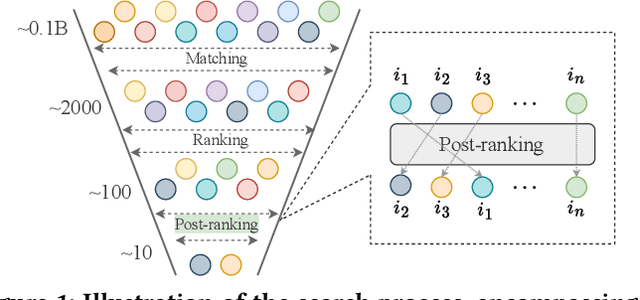



Abstract:Alongside the rapid development of Large Language Models (LLMs), there has been a notable increase in efforts to integrate LLM techniques in information retrieval (IR) and search engines (SE). Recently, an additional post-ranking stage is suggested in SE to enhance user satisfaction in practical applications. Nevertheless, research dedicated to enhancing the post-ranking stage through LLMs remains largely unexplored. In this study, we introduce a novel paradigm named Large Language Models for Post-Ranking in search engine (LLM4PR), which leverages the capabilities of LLMs to accomplish the post-ranking task in SE. Concretely, a Query-Instructed Adapter (QIA) module is designed to derive the user/item representation vectors by incorporating their heterogeneous features. A feature adaptation step is further introduced to align the semantics of user/item representations with the LLM. Finally, the LLM4PR integrates a learning to post-rank step, leveraging both a main task and an auxiliary task to fine-tune the model to adapt the post-ranking task. Experiment studies demonstrate that the proposed framework leads to significant improvements and exhibits state-of-the-art performance compared with other alternatives.
Beyond Relevance: Improving User Engagement by Personalization for Short-Video Search
Sep 17, 2024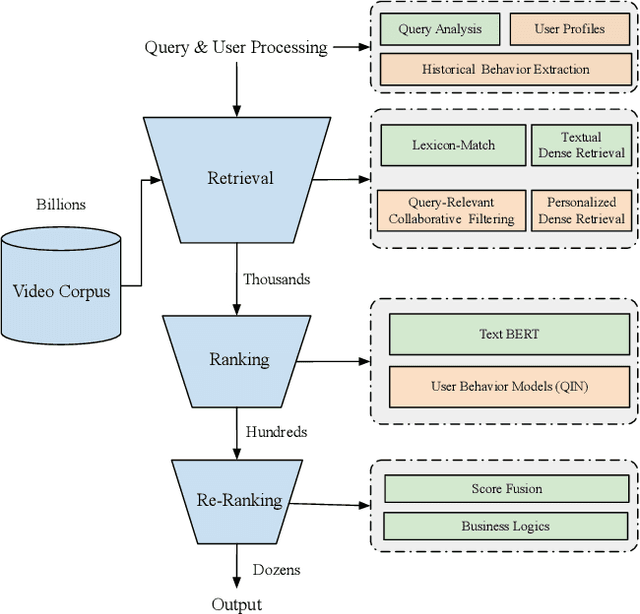
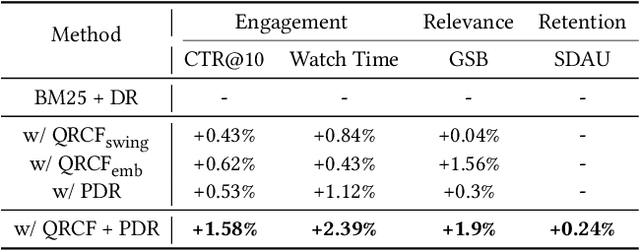
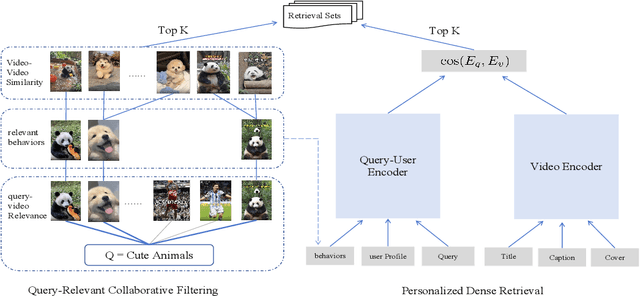

Abstract:Personalized search has been extensively studied in various applications, including web search, e-commerce, social networks, etc. With the soaring popularity of short-video platforms, exemplified by TikTok and Kuaishou, the question arises: can personalization elevate the realm of short-video search, and if so, which techniques hold the key? In this work, we introduce $\text{PR}^2$, a novel and comprehensive solution for personalizing short-video search, where $\text{PR}^2$ stands for the Personalized Retrieval and Ranking augmented search system. Specifically, $\text{PR}^2$ leverages query-relevant collaborative filtering and personalized dense retrieval to extract relevant and individually tailored content from a large-scale video corpus. Furthermore, it utilizes the QIN (Query-Dominate User Interest Network) ranking model, to effectively harness user long-term preferences and real-time behaviors, and efficiently learn from user various implicit feedback through a multi-task learning framework. By deploying the $\text{PR}^2$ in production system, we have achieved the most remarkable user engagement improvements in recent years: a 10.2% increase in CTR@10, a notable 20% surge in video watch time, and a 1.6% uplift of search DAU. We believe the practical insights presented in this work are valuable especially for building and improving personalized search systems for the short video platforms.
DimeRec: A Unified Framework for Enhanced Sequential Recommendation via Generative Diffusion Models
Aug 22, 2024Abstract:Sequential Recommendation (SR) plays a pivotal role in recommender systems by tailoring recommendations to user preferences based on their non-stationary historical interactions. Achieving high-quality performance in SR requires attention to both item representation and diversity. However, designing an SR method that simultaneously optimizes these merits remains a long-standing challenge. In this study, we address this issue by integrating recent generative Diffusion Models (DM) into SR. DM has demonstrated utility in representation learning and diverse image generation. Nevertheless, a straightforward combination of SR and DM leads to sub-optimal performance due to discrepancies in learning objectives (recommendation vs. noise reconstruction) and the respective learning spaces (non-stationary vs. stationary). To overcome this, we propose a novel framework called DimeRec (\textbf{Di}ffusion with \textbf{m}ulti-interest \textbf{e}nhanced \textbf{Rec}ommender). DimeRec synergistically combines a guidance extraction module (GEM) and a generative diffusion aggregation module (DAM). The GEM extracts crucial stationary guidance signals from the user's non-stationary interaction history, while the DAM employs a generative diffusion process conditioned on GEM's outputs to reconstruct and generate consistent recommendations. Our numerical experiments demonstrate that DimeRec significantly outperforms established baseline methods across three publicly available datasets. Furthermore, we have successfully deployed DimeRec on a large-scale short video recommendation platform, serving hundreds of millions of users. Live A/B testing confirms that our method improves both users' time spent and result diversification.
TIM: Temporal Interaction Model in Notification System
Jun 11, 2024



Abstract:Modern mobile applications heavily rely on the notification system to acquire daily active users and enhance user engagement. Being able to proactively reach users, the system has to decide when to send notifications to users. Although many researchers have studied optimizing the timing of sending notifications, they only utilized users' contextual features, without modeling users' behavior patterns. Additionally, these efforts only focus on individual notifications, and there is a lack of studies on optimizing the holistic timing of multiple notifications within a period. To bridge these gaps, we propose the Temporal Interaction Model (TIM), which models users' behavior patterns by estimating CTR in every time slot over a day in our short video application Kuaishou. TIM leverages long-term user historical interaction sequence features such as notification receipts, clicks, watch time and effective views, and employs a temporal attention unit (TAU) to extract user behavior patterns. Moreover, we provide an elegant strategy of holistic notifications send time control to improve user engagement while minimizing disruption. We evaluate the effectiveness of TIM through offline experiments and online A/B tests. The results indicate that TIM is a reliable tool for forecasting user behavior, leading to a remarkable enhancement in user engagement without causing undue disturbance.
CounterCLR: Counterfactual Contrastive Learning with Non-random Missing Data in Recommendation
Feb 08, 2024


Abstract:Recommender systems are designed to learn user preferences from observed feedback and comprise many fundamental tasks, such as rating prediction and post-click conversion rate (pCVR) prediction. However, the observed feedback usually suffer from two issues: selection bias and data sparsity, where biased and insufficient feedback seriously degrade the performance of recommender systems in terms of accuracy and ranking. Existing solutions for handling the issues, such as data imputation and inverse propensity score, are highly susceptible to additional trained imputation or propensity models. In this work, we propose a novel counterfactual contrastive learning framework for recommendation, named CounterCLR, to tackle the problem of non-random missing data by exploiting the advances in contrast learning. Specifically, the proposed CounterCLR employs a deep representation network, called CauNet, to infer non-random missing data in recommendations and perform user preference modeling by further introducing a self-supervised contrastive learning task. Our CounterCLR mitigates the selection bias problem without the need for additional models or estimators, while also enhancing the generalization ability in cases of sparse data. Experiments on real-world datasets demonstrate the effectiveness and superiority of our method.
Unified Language-Vision Pretraining in LLM with Dynamic Discrete Visual Tokenization
Sep 29, 2023
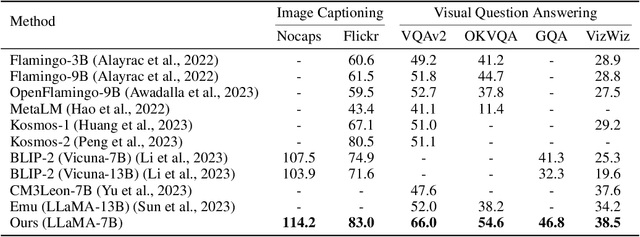

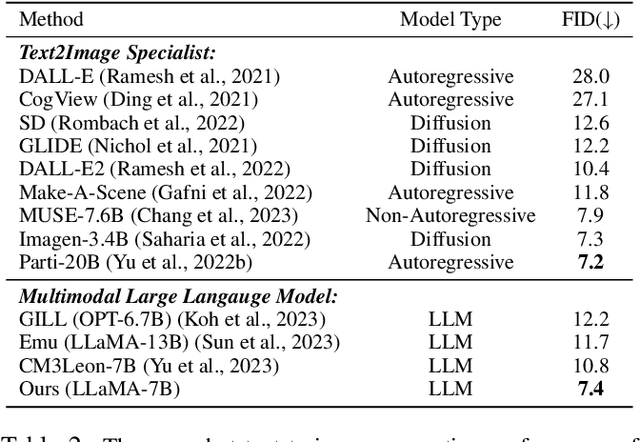
Abstract:Recently, the remarkable advance of the Large Language Model (LLM) has inspired researchers to transfer its extraordinary reasoning capability to both vision and language data. However, the prevailing approaches primarily regard the visual input as a prompt and focus exclusively on optimizing the text generation process conditioned upon vision content by a frozen LLM. Such an inequitable treatment of vision and language heavily constrains the model's potential. In this paper, we break through this limitation by representing both vision and language in a unified form. Specifically, we introduce a well-designed visual tokenizer to translate the non-linguistic image into a sequence of discrete tokens like a foreign language that LLM can read. The resulting visual tokens encompass high-level semantics worthy of a word and also support dynamic sequence length varying from the image. Coped with this tokenizer, the presented foundation model called LaVIT can handle both image and text indiscriminately under the same generative learning paradigm. This unification empowers LaVIT to serve as an impressive generalist interface to understand and generate multi-modal content simultaneously. Extensive experiments further showcase that it outperforms the existing models by a large margin on massive vision-language tasks. Our code and models will be available at https://github.com/jy0205/LaVIT.
From Known to Unknown: Knowledge-guided Transformer for Time-Series Sales Forecasting in Alibaba
Sep 22, 2021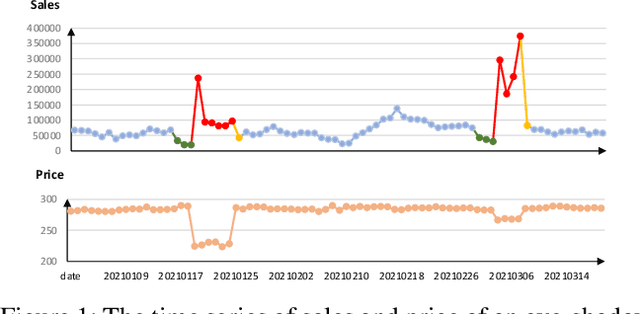
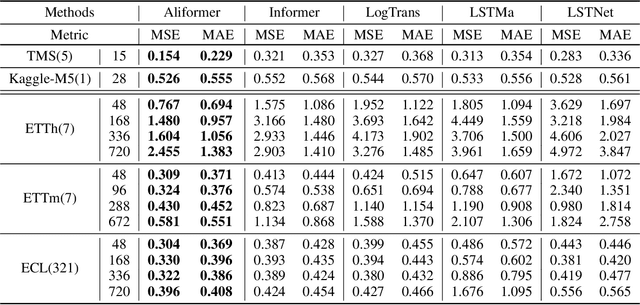
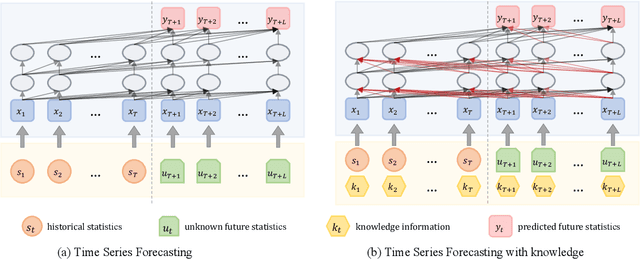
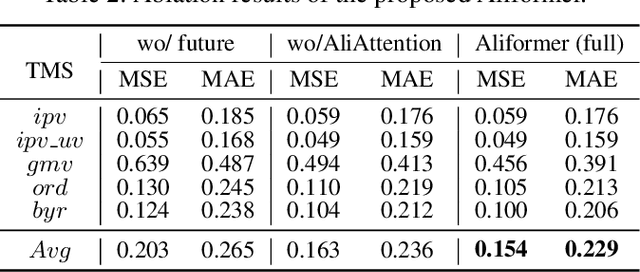
Abstract:Time series forecasting (TSF) is fundamentally required in many real-world applications, such as electricity consumption planning and sales forecasting. In e-commerce, accurate time-series sales forecasting (TSSF) can significantly increase economic benefits. TSSF in e-commerce aims to predict future sales of millions of products. The trend and seasonality of products vary a lot, and the promotion activity heavily influences sales. Besides the above difficulties, we can know some future knowledge in advance except for the historical statistics. Such future knowledge may reflect the influence of the future promotion activity on current sales and help achieve better accuracy. However, most existing TSF methods only predict the future based on historical information. In this work, we make up for the omissions of future knowledge. Except for introducing future knowledge for prediction, we propose Aliformer based on the bidirectional Transformer, which can utilize the historical information, current factor, and future knowledge to predict future sales. Specifically, we design a knowledge-guided self-attention layer that uses known knowledge's consistency to guide the transmission of timing information. And the future-emphasized training strategy is proposed to make the model focus more on the utilization of future knowledge. Extensive experiments on four public benchmark datasets and one proposed large-scale industrial dataset from Tmall demonstrate that Aliformer can perform much better than state-of-the-art TSF methods. Aliformer has been deployed for goods selection on Tmall Industry Tablework, and the dataset will be released upon approval.
 Add to Chrome
Add to Chrome Add to Firefox
Add to Firefox Add to Edge
Add to Edge